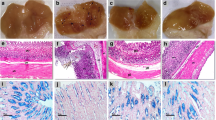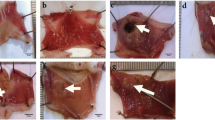Abstract
Although Weilikang decoction (WLK) has been used for gastric ulcer (GU) therapy in a clinical setting with good curative effect for >20 years, the mechanism remains unclear. Several GU animal models, induced by ethanol, hydrochloric acid, aspirin, pylorus ligation, acetic acid and indomethacin, were used to investigate the gastroprotective effects of WLK decoction. Nω-nitro-l-arginine methyl ester hydrochloride (l-NAME), indomethacin, and N-ethylmaleimide (NEM) were pretreated, respectively, to investigate the action mechanism. Real-time polymerase chain reaction and Western blot analysis methods were used to determine the effects of WLK on indomethacin-induced GUs. The WLK-administered groups (2.5, 1.25 and 0.625 g/kg) significantly reduced the GU areas induced by ethanol, hydrochloric acid and aspirin. Furthermore, the effects could be quenched by l-NAME and NEM, but not by indomethacin. The 2.5 and 1.25 g/kg WLK groups showed significantly decreased effects on GU areas induced by pylorus ligation and acetic acid. WLK treatment significantly decreased mRNA expression on cyclooxygenase (COX)-1, COX-2, interleukin-6, tumor necrosis factor α and inducible nitric oxide synthase (iNOS) mRNA, but showed no effect on endothelial nitric oxide synthase mRNA expression. Western blot analysis result showed that WLK-treated groups markedly downregulated COX-2 protein expression. The anti-ulcer potential of WLK can be primarily attributed to its regulatory effects on nitric oxide, sulfhydryl compounds, and reduction effect on mucosal expression of proinflammatory cytokines.








Similar content being viewed by others
References
Young OhT, Ok Ahn B, Jung Jang E, Sang Park J, Jong Park S, Wook Baik H, Hahm KB (2008) Accelerated ulcer healing and resistance to ulcer recurrence with gastroprotectants in rat model of acetic acid-induced gastric ulcer. J Clin Biochem Nutr 42:204–214
Cheng HC, Yang HB, Chang WL, Yeh YC, Tsai YC, Sheu BS (2011) Weak up-regulation of serum response factor in gastric ulcers in patients with co-morbidities is associated with increased risk of recurrent bleeding. BMC Gastroenterol 11:24
Yeh JM, Ho W, Hur C (2010) Cost-effectiveness of endoscopic surveillance of gastric ulcers to improve survival. Gastrointest Endosc 72:33–43
Nartey ET, Ofosuhene M, Agbale CM (2012) Anti-ulcerogenic activity of the root bark extract of the African laburnum “Cassia sieberiana” and its effect on the anti-oxidant defence system in rats. BMC Complement Altern Med 12:247
Dharmani P, De Simone C, Chadee K (2013) The probiotic mixture VSL# 3 accelerates gastric ulcer healing by stimulating vascular endothelial growth factor. PLoS One 8:e58671
Asmari AA, Omani SA, Otaibi MA, Abdulaaly AA, Elfaki I, Yahya KA, Arshaduddin M (2014) Gastroprotective effect of minocycline in experimentally induced gastric ulcers in rats. Int J Clin Exp Med 7:586–596
Rahim NA, Hassandarvish P, Golbabapour S, Ismail S, Tayyab S, Abdulla MA (2014) Gastroprotective effect of ethanolic extract of Curcuma xanthorrhiza leaf against ethanol-induced gastric mucosal lesions in Sprague-Dawley rats. Biomed Res Int 2014:416409
Franco ES, Mélo ME, Jatobá BJ, Santana AL, Silva AA, Silva TG, Nascimento MS, Maia MB (2015) Study of the gastroprotective effect of extracts and semipurified fractions of Chresta martii DC. and identification of its principal compounds. Evid Based Complement Altern Med 15:576495
Caldas GF, Oliveira AR, Araújo AV, Quixabeira DC, Silva-Neto Jda C, Costa-Silva JH, de Menezes IR, Ferreira F, Leite AC, da Costa JG, Wanderley AG (2014) Gastroprotective and ulcer healing effects of essential oil of Hyptis martiusii Benth (Lamiaceae). PLoS One 9:e84400
Novotna A, Srovnalova A, Svecarova M, Korhonova M, Bartonkova I, Dvorak Z (2014) Differential effects of omeprazole and lansoprazole enantiomers on aryl hydrocarbon receptor in human hepatocytes and cell lines. PLoS One 9:e98711
Inan A, Sen M, Sürgit O, Ergin M, Bozer M (2009) Effects of the histamine H2 receptor antagonist famotidine on the healing of colonic anastomosis in rats. Clinics (Sao Paulo) 64:567–570
Takeuchi K (2012) Pathogenesis of NSAID-induced gastric damage: importance of cyclooxygenase inhibition and gastric hypermotility. World J Gastroenterol 18:2147–2160
Kang JW, Yun N, Han HJ, Kim JY, Lee SM (2014) Protective effect of flos Lonicerae against experimental gastric ulcers in rats: mechanisms of antioxidant and anti-inflammatory action. Evid Based Complement Alternat Med 2014:596920
Guo G, Ai Y (2002) Weilikang and H2-receptor blocker in combination with antibiotic in the treatment of active peptic ulcer. Heilongjiang Yiyaokexue 25:22–23
Olaleye SB, Farombi EO (2006) Attenuation of indomethacin- and HCl/ethanol-induced oxidative gastric mucosa damage in rats by kolaviron, a natural biflavonoid of Garcinia kola seed. Phytother Res 20:14–20
Lichtenberger LM, Romero JJ, Dial EJ (2007) Surface phospholipids in gastric injury and protection when a selective cyclooxygenase-2 inhibitor (Coxib) is used in combination with aspirin. Br J Pharmacol 150:913–919
Kawamura N, Ito Y, Sasaki M, Iida A, Mizuno M, Ogasawara N, Funaki Y, Kasugai K (2013) Low-dose aspirin-associated upper gastric and duodenal ulcers in Japanese patients with no previous history of peptic ulcers. BMC Res Notes 6:455
Murphy TV, Kotecha N, Hill MA (2007) Endothelium-independent constriction of isolated, pressurized arterioles by Nω-nitro-l-arginine methyl ester (l-NAME). Br J Pharmacol 151:602–609
Suleyman H, Albayrak A, Bilici M, Cadirci E, Halici Z (2010) Different mechanisms in formation and prevention of indomethacin-induced gastric ulcers. Inflammation 33:224–234
Zhang X, Tajima K, Kageyama K, Kyoi T (2008) Irsogladine maleate suppresses indomethacin-induced elevation of proinflammatory cytokines and gastric injury in rats. World J Gastroenterol 14:4784–4790
Luiz-Ferreira A, Cola M, Barbastefano V, de-Faria FM, Almeida AB, Farias-Silva E, Calvo TR, Hiruma-Lima CA, Vilegas W, Souza-Brito AR (2012) Healing, antioxidant and cytoprotective properties of Indigofera truxillensis in different models of gastric ulcer in rats. Int J Mol Sci 13:14973–14991
Guidobono F, Pagani F, Ticozzi C, Sibilia V, Netti C (1998) Investigation on the mechanisms involved in the central protective effect of amylin on gastric ulcers in rats. Br J Pharmacol 125:23–28
Takeuchi K, Okabe S, Takagi K (1976) A new model of stress ulcer in the rat with pylorus ligation and its pathogenesis. Am J Dig Dis 21:782–788
Melese E, Asres K, Asad M, Engidawork E (2011) Evaluation of the antipeptic ulcer activity of the leaf extract of Plantago lanceolata L. in rodents. Phytother Res 25:1174–1180
Sidahmed HM, Azizan AH, Mohan S, Abdulla MA, Abdelwahab SI, Taha MM, Hadi AH, Ketuly KA, Hashim NM, Loke MF, Vadivelu J (2013) Gastroprotective effect of desmosdumotin C isolated from Mitrella kentii against ethanol-induced gastric mucosal hemorrhage in rats: possible involvement of glutathione, heat-shock protein-70, sulfhydryl compounds, nitric oxide, and anti-helicobacter pylori activity. BMC Complement Altern Med 13:183
Nartey ET, Ofosuhene M, Kudzi W, Agbale CM (2012) Antioxidant and gastric cytoprotective prostaglandins properties of Cassia sieberiana roots bark extract as an anti-ulcerogenic agent. BMC Complement Altern Med 12:65
Amirshahrokhi K, Khalili AR (2015) The effect of thalidomide on ethanol-induced gastric mucosal damage in mice: involvement of inflammatory cytokines and nitric oxide. Chem Biol Interact 225:63–69
Guha P, Dey A, Chatterjee A, Chattopadhyay S, Bandyopadhyay SK (2010) Pro-ulcer effects of resveratrol in mice with indomethacin-induced gastric ulcers are reversed by l-arginine. Br J Pharmacol 159:726–734
Zaghlool SS, Shehata BA, Abo-Seif AA, Abd El-Latif HA (2015) Protective effects of ginger and marshmallow extracts on indomethacin-induced peptic ulcer in rats. J Nat Sci Biol Med 6:421–428
Antonisamy P, Kannan P, Aravinthan A, Duraipandiyan V, Arasu MV, Ignacimuthu S, Al-Dhabi NA, Kim JH (2014) Gastroprotective activity of violacein isolated from Chromobacterium violaceum on indomethacin-induced gastric lesions in rats: investigation of potential mechanisms of action. Sci World J 2014:616432
Jiang GL, Im WB, Donde Y, Wheeler LA (2009) EP4 agonist alleviates indomethacin-induced gastric lesions and promotes chronic gastric ulcer healing. World J Gastroenterol 15:5149–5156
Banerjee D, Maity B, Nag SK, Bandyopadhyay SK, Chattopadhyay S (2008) Healing potential of Picrorhiza kurroa (Scrofulariaceae) rhizomes against indomethacin-induced gastric ulceration: a mechanistic exploration. BMC Complement Altern Med 8:3
Alumets J, Ekelund M, Håkanson R, Hedenbro J, Rehfeld J, Sundler F, Vallgren S (1982) Gastric acid response to pylorus ligation in rats: is gastrin or histamine involved? J Physiol 323:145–156
Okabe S, Amagase K (2005) An overview of acetic acid ulcer models-the history and state of the art of peptic ulcer research. Biol Pharm Bull 28:1321–1341
Shahrokhi N, Keshavarzi Z, Khaksari M (2015) Ulcer healing activity of Mumijo aqueous extract against acetic acid induced gastric ulcer in rats. J Pharm Bioallied Sci 7:56–59
Acknowledgments
This research was supported by the Program for Important Drug Development of MOST, China (2013ZX09402201001), New Century Excellent Talents in University (NCET-12-1069), and Tianjin Innovative Research Team in University (TD12-5033).
Author information
Authors and Affiliations
Corresponding authors
Rights and permissions
About this article
Cite this article
Wang, S., Ni, Y., Liu, J. et al. Protective effects of Weilikang decoction on gastric ulcers and possible mechanisms. J Nat Med 70, 391–403 (2016). https://doi.org/10.1007/s11418-016-0985-1
Received:
Accepted:
Published:
Issue Date:
DOI: https://doi.org/10.1007/s11418-016-0985-1




